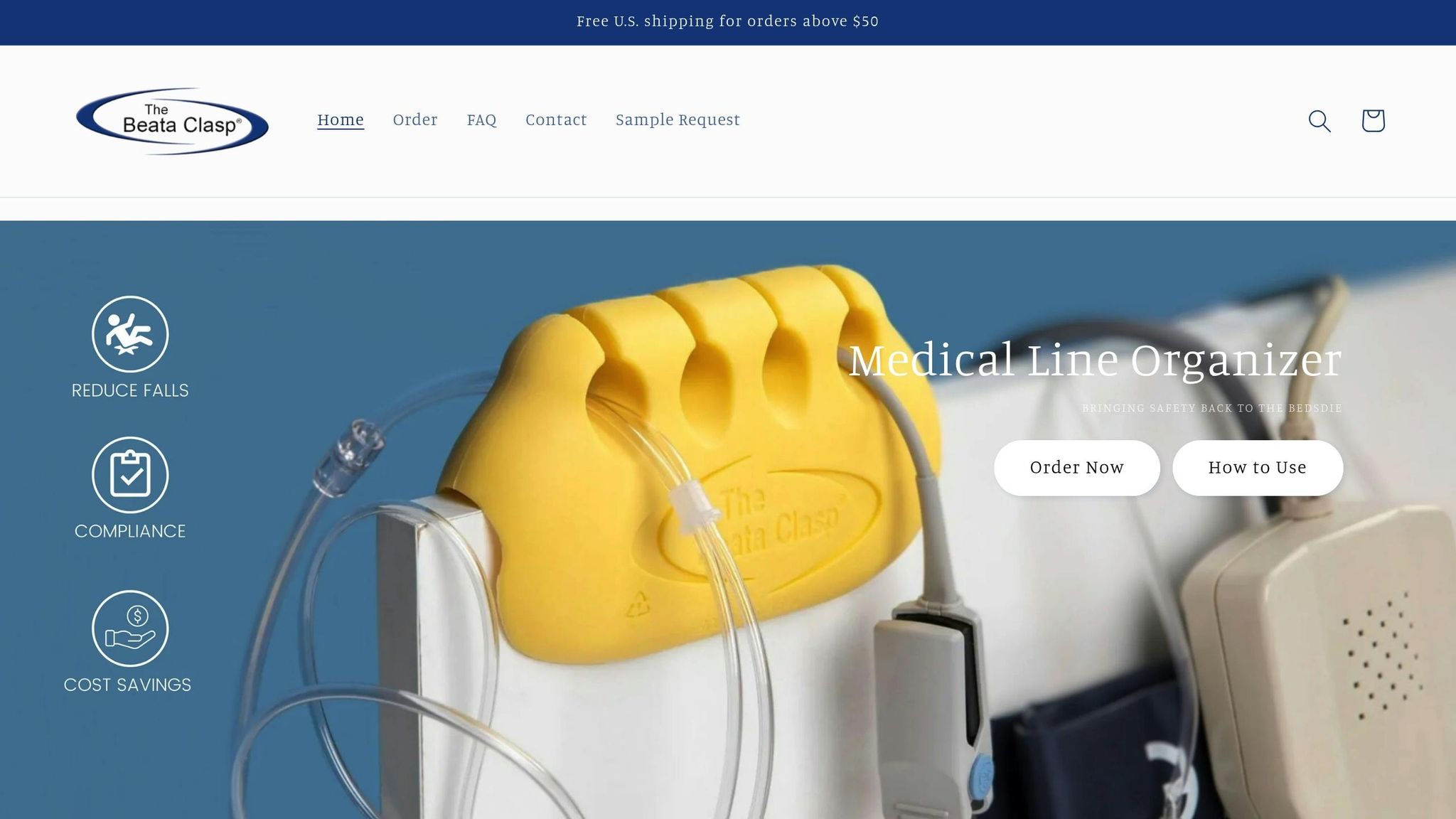Nurses are the backbone of patient safety, especially during IV therapy. Yet, they face constant challenges like tangled lines, contamination risks, and workflow disruptions that impact both care quality and their own efficiency. WorldMed’s Line Safety Initiative aims to address these issues with tools like the Beata Clasp, designed by nurses for nurses. This simple, affordable device helps prevent line tangles, reduces infection risks, and saves time, allowing nurses to focus on what matters most: patient care. Early results show fewer complications, improved safety, and better outcomes for both patients and healthcare staff.
IV Insertion Mistakes to Avoid Nursing | IV Cannulation Technique Mistakes
IV Line Management Problems: Risks and Consequences
IV therapy is a cornerstone of modern healthcare, but managing IV lines comes with its own set of challenges. These aren't just minor inconveniences - they can lead to serious risks for patients and create additional strain on healthcare providers.
Common IV Therapy Risks
Line entanglement is one of the most frequent issues. When multiple IV lines become twisted, patients may trip while trying to move, leading to falls and injuries. Untangling these lines can also damage them, delaying necessary treatments.
Contamination risks arise when IV lines touch unclean surfaces, like the floor. Dropped lines can pick up bacteria or other pathogens, potentially leading to infections and delaying care.
Misconnections happen when IV lines are poorly organized or labeled. In busy environments, this can result in medications being administered incorrectly, with potentially harmful outcomes.
Workflow disruptions occur when nurses are forced to stop their tasks to address tangled or compromised lines, pulling them away from other critical responsibilities.
Patient mobility restrictions are another concern. Poorly managed IV lines can make it harder for patients to move freely, slowing their recovery and increasing the likelihood of complications.
Each of these risks not only threatens patient safety but also adds to the workload of healthcare staff.
How These Problems Affect Patients and Workflow
The consequences of poor IV line management can be significant. Contaminated lines or lapses in sterile procedures increase the chances of healthcare-associated infections, which can lead to longer hospital stays and more complex treatments. Patients may also feel frustrated by delays, restricted movement, or even injuries caused by falls, all of which can lower their overall satisfaction with care.
For nurses, these issues translate into lost time. Instead of focusing on direct patient care or timely medication administration, they’re often stuck addressing tangled lines or replacing contaminated ones. This added workload not only disrupts workflows but also contributes to stress and burnout among healthcare workers. On top of that, incidents like contamination or line replacements require detailed documentation, further increasing administrative tasks.
The financial toll on healthcare facilities is also considerable. Resources are diverted to replace damaged lines, treat infections, manage falls, and address workflow inefficiencies, all of which add up over time.
These challenges highlight the urgent need for practical, nurse-led solutions that improve workflows and prioritize patient safety. By addressing these issues, healthcare teams can focus on what truly matters: providing quality care.
WorldMed's Nurse-Focused IV Line Safety Solutions

WorldMed understands the challenges nurses face when managing IV lines and has developed practical tools to make their jobs easier. Instead of introducing complicated systems that could disrupt workflows, the company designed solutions that fit seamlessly into nurses’ daily routines. These tools address common issues with IV line management, offering practical and nurse-centered solutions.
New Tools for IV Line Management
WorldMed's Line Management and Alignment Program (LMAP) tackles workflow disruptions with a combination of specialized tools and targeted training aimed at reducing IV line entanglement and contamination.
Key features of this program include the use of antimicrobial materials, which help prevent infections and are easy to clean. The tools are also color-coded, allowing nurses to quickly identify different lines, even in low-light conditions. In addition, the design avoids crevices where bacteria could accumulate and is completely latex-free, addressing concerns about latex allergies.
How Beata Clasp Helps Nurses

The Beata Clasp takes IV line management to the next level, focusing on improving organization and safety. Created by two registered nurses familiar with the daily struggles of managing IV lines, the clasp directly addresses issues like line entanglement and safety hazards.
One of its standout features is its ability to separate IV lines, preventing tangles and saving nurses valuable time. By keeping lines off the floor, the device also reduces the risk of trips and falls in busy healthcare environments.
The Beata Clasp is designed for efficiency, with an attachment system that eliminates the need for adhesives or complicated setups. This allows for quick and secure line management, whether for a single patient or multiple patients. Its antimicrobial surface supports infection control efforts without adding extra cleaning steps.
In addition to improving safety, the Beata Clasp is cost-effective. Priced at $19.95 per unit, with packs of 10 available for $163.00 and bulk orders of 25 for $467.50, it offers an affordable solution for healthcare facilities. Plus, its recyclable design supports sustainability efforts, helping organizations reduce their environmental impact while maintaining high standards of patient care.
sbb-itb-f779e18
Results from Clinical Settings: Actual Implementation
The early adoption of these tools in clinical environments highlights their practical advantages. Initial reports suggest that nurse-centered IV line management solutions are improving patient safety while simplifying workflows.
Hospital and Clinic Examples
These tools are being tested in various settings, including hospitals, ICUs, emergency departments, and home care environments. Early pilot programs in these areas have shown noticeable improvements in IV line organization and workflow efficiency, offering a glimpse into their potential to create meaningful change in clinical practices.
Better Outcomes for Patients and Staff
Drawing inspiration from the design principles of the Beata Clasp, these trials have already demonstrated safer and more efficient IV line management. Early findings reveal better organization of IV lines, smoother nursing handoffs, and improved infection control measures. Its portability ensures that IV lines can be managed safely across different care settings. Since the Beata Clasp was created by registered nurses, its features are tailored to address the challenges faced in daily clinical work. Ongoing research will provide further evidence to support these promising results.
Conclusion: Better Patient Safety Through Nurse Empowerment
WorldMed's Line Safety Initiative highlights how empowering nurses can lead to safer patient outcomes. By positioning nurses as key players in safety innovation, the program demonstrates how tailored solutions can bring real improvements to IV therapy management. These results not only validate the current approach but also open doors for advancements in IV line management.
Main Points
As discussed earlier, giving nurses the tools and authority they need transforms IV line management and directly influences patient care. Clinical data shows that nurse-led approaches produce measurable improvements. Purpose-built tools allow nurses to focus more on patients, reducing distractions and inefficiencies.
The numbers speak for themselves: leakage rates dropped from 18% to just 1%, and catheter dwell times increased from 67 to 103 hours. These results, combined with cost-effective pricing, underline the value of these tools in IV line management. The return on investment becomes clear when factoring in fewer complications, reduced need for line replacements, and enhanced nursing efficiency.
With these documented successes, the future of IV line safety looks increasingly bright.
What's Next: The Future of Line Safety
The success of nurse-driven innovations like the Beata Clasp points toward an exciting path for healthcare improvements. As more healthcare facilities embrace the idea of equipping nurses with better tools and training, continued progress in IV therapy outcomes across the U.S. seems inevitable.
Looking ahead, we can expect these solutions to expand into specialized care settings and integrate with new healthcare technologies. WorldMed's Line Safety Initiative has laid a strong foundation for collaboration among nurses, healthcare leaders, and medical device manufacturers to tackle ongoing challenges in patient safety.
The mission remains clear: safer patients through empowered nurses. By prioritizing nurse-centered solutions, healthcare organizations create a positive cycle - better tools lead to improved outcomes, which then foster innovation and greater job satisfaction for nurses. This approach benefits everyone involved, especially the patients who rely on safe, effective care.
FAQs
How does Beata Clasp help prevent IV line contamination and tangling?
The Beata Clasp is built to keep IV lines securely in place with its carefully designed circular grooves. These grooves help prevent lines from tangling, getting dislodged, or being pinched, which lowers the risk of contamination. By keeping IV lines neatly organized and stable, the Beata Clasp improves patient safety and streamlines nursing tasks, leading to smoother workflows and better care delivery.
How do nurse-focused solutions like the Beata Clasp improve patient safety and streamline workflows?
Nurse-centered tools like the Beata Clasp play a key role in boosting patient safety and streamlining daily tasks in clinical environments. By tackling frequent challenges, these tools help cut down on errors, lower infection risks, and make workflows smoother, enabling nurses to provide higher-quality care.
Research highlights that refining clinical workflows and cultivating a safety-first mindset greatly influence patient outcomes. When work processes are optimized, mistakes decrease, and nurses can dedicate more time to patient care. Focusing on solutions designed with nurses in mind helps create safer healthcare settings and ensures operations run more efficiently.
What are the cost benefits of using the Beata Clasp compared to traditional IV line management methods?
The Beata Clasp helps healthcare facilities cut costs by addressing common issues like IV line dislodgement, entanglement, and related complications. By reducing these problems, it decreases the need for extra supplies and corrective measures, which can significantly lower operational expenses.
Unlike traditional methods that depend on single-use adhesive tapes and constant line adjustments, the Beata Clasp offers a reusable, adhesive-free alternative. This design simplifies workflows, improves efficiency, and reduces errors. The result? Enhanced patient safety and smarter resource use - an investment that makes sense for facilities aiming to deliver high-quality care while keeping costs under control.
